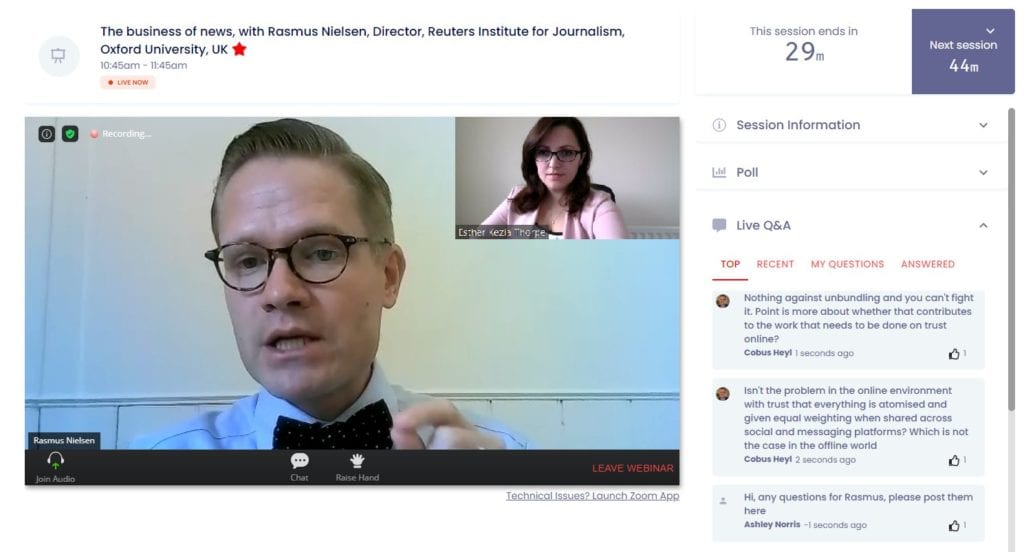|
Getting your Trinity Audio player ready...
|
The events of this year have laid bare a very real issue with many news business models. Publishers have seen record-breaking levels of traffic and engagement with their content as people search out trustworthy updates on the pandemic, but ad revenue has plunged. A business model that was already in decline has crumbled faster under pressure.
In a wide-ranging discussion about the Business of News at FIPP’s World Media Congress 2020, Rasmus Kleis Nielsen, Director at the Reuters Institute for the Study of Journalism at Oxford University discussed some of the issues with news publishing that have been exacerbated by the pandemic, and what news organisations have been doing to weather the storm.

A broken relationship
For many publishers, the pandemic has accelerated trends in advertising decline, and the level of recovery is still uncertain. “Things were difficult enough as they were, and a challenging situation has just become much more challenging for a lot of organisations, with the cyclical impact of the sharp recession that follows from the pandemic,” Nielsen said.
He pointed out that although advertising had been an important part of the revenue mix for news publishers for a long time, that wasn’t because advertisers cared about news.
“That’s not why they spend money with us,” he explained. “They spend money with us because they want to move product and improve their brand. And if they don’t feel that news publishers are offering the most efficient and credible way of achieving the goals that advertisers actually have, then they’re going to move their money elsewhere.”
“Advertisers were never interested in journalism or the news. They were interested in the audiences,” Nielsen added. It is therefore not surprising that keyword blocking ended up depriving reputable publishers of tens of thousands of pounds of ad revenue, as advertisers sought to avoid controversial topics.
However, Nielsen emphasised that publishers should take pride in how people flocked to credible news organisations during the pandemic. It’s a powerful illustration and a reminder of the role that journalism plays in our societies, and even those who are sceptical of news organisations have turned to them to help them understand the situation. But the business end has highlighted the deficiencies of the scale model.
“Traffic is a means to an end. Traffic does not come with money,” he explained. “Traffic is something you can convert to revenue from various forms of monetisation, whether it’s advertising, reader revenue, or other areas. During a recession, of course the traffic is going to be worthless. There is no way in which the market alone will reward you for just the traffic.”
Going forward, advertising will be a much smaller part of the revenue mix for news organisations; a fact that publishers are already aware of. Nielsen thinks that this is because news captures a much smaller share of attention than it used to, because of where people spend their time online. But ads still have a part to play in a mix.
“A smaller part of a very large pie can still be a meaningful revenue stream,” he pointed out. “If news publishing accounts for 5% of global digital advertising, that’s $15 billion. That’s a lot less than we used to make, but it’s still a lot of money. No one wants to leave that on the table.”
Taking advantage of the Covid boost
One of the rare bright spots of the pandemic for publishers has been a boost in subscribers for those with a reader revenue model. Publishers from The Atlantic to Quartz, Conde Nast and Bauer have seen readers flock to pay for printed magazines and access to online content, either as entertainment during lockdown or as a way to support journalism.
Even heavily paywalled publishers who chose to make Covid coverage free have seen growth. Bloomberg and the Wall Street Journal are two publishers who saw record subscriber numbers in early 2020, despite putting virus-related content outside of their paywalls.
There has been a mixed reaction to these moves. On the one hand, vital information about public health should be free to access. But others have argued that just because something is essential, doesn’t mean it should be free.
Nielsen is sympathetic to the sentiment behind the decision to make Covid coverage free, but doesn’t believe this is a sustainable strategy for publishers. “In any situation like this, I understand the desire to share [the journalism] more broadley,” he said. “But fundamentally, we have to recognise that if we want to matter – not just now, but for the foreseeable future – we have to find sustainable ways of funding the work that we do.”
As the crisis draws out, Nielsen thinks publishers should be considering the long term plans for the free coverage. He highlighted Swedish newspaper Svenska DagBladet (SvD) and elDiario in Spain as examples of publishers with strong digital strategies who have used the pandemic to illustrate the importance of their journalism and convinced people to support them financially.
“Publishers need to think very hard about how long these things are free, and where they are free, that they have a very clear strategy for trying to use the increased audience, to try and recruit new subscribers and members,” he added.
Will willingness to pay evolve?
Although the pandemic has increased the number of people paying for a subscription, it remains to be seen whether those same people will continue to pay next year, and how many outlets they are willing to support. The Reuters Digital News Report 2020 found a small increase in those willing to pay for more than one subscription in the US and Norway.
Predicting future behaviours in this area is incredibly difficult, particularly with a pandemic affecting people’s behaviour and income. But Nielsen says the trends towards spending are positive. “While this is not the way in which it looks on our balance sheet and as news publishers, we need to remember that from the point of view of most citizens, they’re probably spending more money on media than they ever have,” he pointed out.
This can encompass hardware, connectivity, mobile plans, and then subscriptions to on-demand services like Netflix, Spotify, and gaming subscriptions. The household spend hasn’t gone down, it’s shifted to other points in the value chain, and news has shrunk dramatically.
Despite this, Nielsen still thinks there are benefits for publishers. The challenge for the past 20 years has been that news has been freely available, and many people have grown up accustomed to getting it for free. Attempts over the years to extract payment for news have been clumsy and badly executed, such as lengthy payment journeys.
“But as more and more people leave the culture of free behind, and are accustomed to paying for premium, valuable experiences…that is changing what economists would call the reference price, and creating opportunities for news publishers as well to charge,” he said.
“We have found positive correlations between paying for things like Netflix and paying for news. It’s not a zero-sum or crowding out, it’s a positive relation.”
Projecting and modelling this behaviour forward into the future is difficult. Nielsen’s own view is that paying for news in the same way as Spotify or Netflix is unlikely to become a majority behaviour, as so much news is still free to access. But he does see opportunities for those who do pay, albeit not in a balanced way for the market.
“If you’re one of the winners of this market, you can imagine a world in the very near future where the most successful upmarket national brands have more subscribers than they’ve ever had in their history,” he speculated. “There will be higher margins from each individual subscriber than they’ve ever had because it’s digital and you’ve got rid of the production and distribution costs.”
This in turn leads to a virtuous circle where these publishers – like the New York Times and The Washington Post – are able to invest in their journalism, attract more subscribers and strengthen themselves further.
But for smaller publications, this is likely to present problems. “If you’re a metro newspaper, you have Facebook and Google eating your advertising on one side, and then you have Mark Thompson, Meredith Levien and Fred Ryan eating your subscribers from the other side.” Nielsen mused. “That’s a tough place to be.”
Post-pandemic models for news
When it comes to the outlook for the future of news, Nielsen describes himself as a “cautious, evidence-based optimist.” While the overall picture is very tough, and a number of struggling publishers are unlikely to make it, he believes that the path forward is becoming clearer.
“While we’re still seeing how the pandemic will affect things, I feel we’ve reached a point in the last couple of years,” he outlined. “We’re beginning to see proof of concept of a range of different models that demonstrably work for providing really important special reporting on issues of public interest and have built a significant audience.”
Nielsen highlighted a number of different types of models that are proving sustainable if implemented well. Subscriptions, memberships, nonprofits and even advertising models are still performing strongly for publishers in France, Spain, South Africa, Malaysia, France and the US, to name a few.
“It’s tough, I don’t think we can pretend otherwise,” he said. “But we are seeing a growing number of really impressive, forward-looking organisations who are doing digital journalism for a digital audience in a digital age, and are making money off of it.”
“This isn’t in a way that is as lucrative as the 1990s for many of them, but in a way that’s sustainable and that gives me confidence in the future. Local will be tough. Many will struggle. But I think we’re seeing more and more examples of success, and I really admire those people,” he concluded.
FIPP’s World Media Congress 2020 runs until 30th September. See the agenda and register to access all the sessions on demand here.



